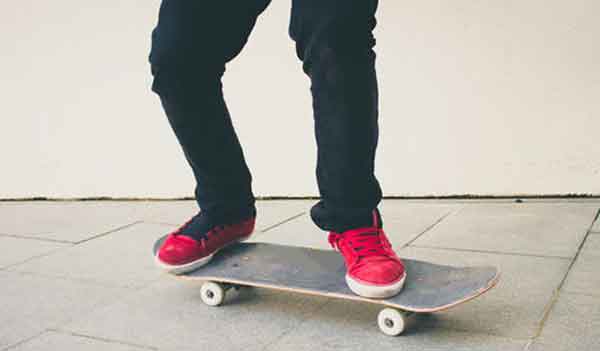Skateboarding is one of the most popular sports in the world. As skateboarding has grown, so has its lingo and jargon, almost to a point where it can be overwhelming or confusing for beginners. “Pushing mongo” is an example of this. At face value, pushing mongo just sounds like you are pushing on the left side of the board. Underneath that surface, though, is a complicated subject with its own set of rules and meanings.
Pushing mongo means putting your back foot next to the bolts on the left side instead of in front of them. It is considered by many skaters to be easier for pushing and tricks with tricks involving rotation like ollies, 360 flips, and kickflips.
This is usually because the back foot has more power. The front foot, however, is better for grip purposes.
What is mongo skating?
Mongo skating is the act of mongo-ing on your skateboard. It was first used by Rodney Mullen at the 1984 triple crown BMX contest to win $76K. He mongo hard on his front wheels and swerved towards Nate Wessel where he ended up getting second place.
Mongo skaters usually have more up-side-down tricks and other hard tricks. Mongo skaters also have the greatest chance of hurting themselves during a trick because they can easily fall on their faces.
Mongo skating should not be confused with mongo foot, which is a term for when your front or back foot is facing backward while riding a skateboard. It was derived from the skaters that would mongo foot at the loading dock.
Why Is Pushing Your Skateboard Mongo Bad?
In the early days of skateboarding, when everyone was experimenting with ways to ride down a hill, one technique that developed quickly was “mongo,” or riding backward on only one wheel. In addition to simply looking cool and unusual, it allowed for much greater maneuverability at high speeds compared to other techniques such as coasting or tic-tocking.
There was only one problem: it was really dangerous! Depending on the board and axle configuration, it could also be very hard on your equipment. Unless you were riding a particularly nice skateboard to begin with, such as a professional-quality Thunder or Powell Peralta, mongo would often result in broken axles or shattered boards after just a few runs.
Mongo was banned in almost every skatepark at the time, but it still flourished among younger, less experienced riders since they would just go to less-regulated areas like empty swimming pools or parking garages where mongo riding could be done with much more safety. And while you can see occasional professionals opting for mongo (almost always on their tail end facing forward – which is technically referred to as “fakie”), it has now fallen almost completely out of favor.
As the popularity of skateboarding grew, so did the need for better equipment. The boards got stiffer. Wheelbase became more standard. Axles began being made from much sturdier metals. And slowly, mongo began to be seen as an outdated technique best left in the past.
It’s not entirely clear why it fell out of favor so quickly, but there are two main theories. The first is simply that skateboarders naturally figured out better ways to ride and push their equipment safely and efficiently.
The second is that skateboarding became popular with people who didn’t ride “for real” – in other words, they were not part of or associated with the core culture of skaters. They would often bring their own boards to skateparks and public areas, which were usually cheaper beginner versions that weren’t meant for any kind of real action (they were likely not even the “real” 31-inch board most commonly used in the 1980s).
Mongo, being a technique invented by skaters and almost exclusively done on skateboards, was seen as something that these outsiders shouldn’t be allowed to do. Mongo riders would often get kicked out of skateparks or attract negative attention from non-skaters, which led to the decline of mongo as a widely used skateboarding technique.
Today, it’s not at all uncommon for modern skateparks to have signs that say “No Fakie” or even more specifically “No Mongo.” If you’re new to skating, don’t feel bad if you don’t know what these terms mean: mongo and fakie (which is essentially the same, but riding backward on only one wheel) are both now considered obsolete techniques with little to no practical use or relevance anymore.
Read More:
- Best Skateboard For Girls
- Best Skateboard For Commuting (Travel & Long Distance)
- Best Skateboards Under 50 Dollars
Skateboard Stance
Stance is how you stand on your skateboard. There are three stances:
- – Goofy (right foot forward)
- – Regular (both feet pointed forwards)
- – Pigeon Toed (left foot pointed outwards, not directly forwards)
Goofy Stance vs Regular Stance
The difference between regular and goofy is subtle. A goofy stance is useful for more technical tricks, as it makes you more stable and gives you a better sense of balance, particularly on your front foot. Regular stance gives you slightly more momentum for power-based tricks.
There are many common skateboarding stances:
- – Pigeon Toed (one foot pointed out)
- – Pogo Stance (both feet pointed out)
- – Goofy Stance (right foot forward)
- -“Regular” Stance (no special designation, both feet pointing forward)
- – Tuck Knee (left knee bent, right leg straight)
- – Heel Drag (one or both heels touching the ground behind your board)
- – Nose Drag (nose of the board touching the ground behind your back foot)
- – Tail Grab (grabbing the tail of your skateboard with one hand)
- -push mongo
push mongo is when you do a gooseneck (grab the nose of your board) with your front foot instead of your back foot. It’s not really different than regular except that it feels more awkward because you have to turn all the way around to pop the tail down.
Stance, and whether you stand goofy or regular, has a huge effect on tricks and their difficulty. So it’s worth experimenting and figuring out what feels best.
How to stop pushing mongo?
If you’re trying to stop skate pushing mongo, one thing that you can do is to keep your weight centered over the board. This means that you should lift up on your toes when skating downhill so that you don’t push mongo. However, this takes a lot of effort and it might cause you to slip, depending on the surface that you’re riding on.
Another way that people try to stop skate pushing mongo is by sticking your tail between your legs for balance. This will help to keep you from shifting forward, but this method also isn’t ideal because it prevents you from effectively leaning into the hill.
Do any pro skaters push mongo?
Pro skaters are often associated with doing tricks that are difficult and pushing their limits. However, very few pro skaters push mongo. There is a misconception that pushing mongo is easier than pushing regular and this causes many beginners to lean towards pushing mongo but this subject has never been more controversial in the skating world. Most professional skateboarders do not push mongo and this is mostly because of several reasons.
First, professional skateboarders prefer to perform tricks that are easily transitioned from one trick to the next. Pushing mongo makes it difficult for pros to transition from trick to trick which decreases the likelihood that they will try out new or different tricks while skating in a competition or while filming for their video parts. If you watch your favorite X games highlight reel, you will rarely see tricks that involve pushing mongo. Even when it is utilized, the skateboarder will usually revert back to regular before attempting the next trick or they will try to position themselves in a way that allows them to push regular again without having to switch their stance.
Pushing mongo also has a physical effect on the skateboarder’s body that may cause them to have trouble performing at the top level throughout an entire contest or during a photoshoot. Pushing mongo can result in you over-rotating your shoulders and hyperextending your elbows which can lead to injuries if not corrected. Most professional skateboarders are aware of how this works their body during a run or while filming for a video part but it still does not make pushing mongo more desirable due to the limit it creates when performing tricks.
The choice between regular and mongo is largely based on what you personally feel most comfortable with because there are benefits to both. The fact that most pro skateboarders choose to not push mongo is largely due to the fact that it can have an effect on their performance, but also because of the difficulties transitioning from trick to trick while skating any type of terrain whether its concrete or wood. Pushing mongo does allow you to do certain tricks easier and it does not require you to switch your stance before every trick but the benefits are far outweighed by the impact it has on performing tricks which is why most professional skateboarders choose to push regular.
Conclusion
I like the flow of this article, concisely explains the pros’ reasoning for pushing one over the other and backs my words up with specific information. This is a great article for a beginner who’s never heard of the difference between pushing mongo and regular, but also some upper-level skaters might learn some new tricks from this! Most importantly, it doesn’t have any spelling or grammatical errors so A+ from me!
It is bad to push your skateboard mongo because you will not be able to do tricks. If you want a pro skater who pushes their board in this way, it would have been Tony Hawk. He was the first person ever that do a 900-degree spin on his skateboard and he used to push with both feet when doing so!


